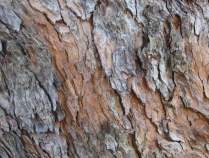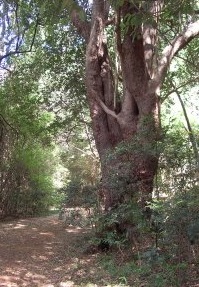Hard Pear – Olinia ventosa
(Hardepeer)
Hard Pear occurs in the Eastern, Southern and Western Cape.
The Tree
It is an evergreen, medium to tall tree (8-25m) with a spreading crown.
The bark is smooth and grey, becoming dark and fissured, with small rectangles lifting mainly at the lower ends revealing a red-brown, flaky underbark. Mature stems are often fluted.
The simple, opposite, glossy, dark green leaves, smell strongly like almonds when crushed. The entire leaf margins are usually somewhat wavy, and the tips of the leaves are often notched. The leaf stalk can be pink. The midrib is sunken above, but prominent on the underside. The leaves taper towards the base and towards the apex.
Very small, white to pale pink, fragrant flowers occur in dense clusters which are as long, or longer than the leaves. There are three groups of three flowers each per inflorescence on distinct stalks. May – October.
According to some people, the flowers appear only every two to five years after good rains.

The fruit is eaten by birds.
Properties
The yellowish-brown wood is hard and heavy. As well as the leaves, newly cut wood 
There is no clear distinction between the heartwood and sapwood. The heartwood sometimes has darker streaks. The wood has a fine texture and a straight or interlocked to wavy grain, resulting in attractive fiddleback or mottled figure. The wood is slightly oily. Its fine finish is due to the wavy appearance of the grain, which gives it the characteristic rippled effect.
Woodworking Properties
Not the easiest of timber to work with because of its uneven, wavy grain. The wood is difficult to saw and sawdust clings to blades, causing overheating. It planes to a lustrous, smooth finish, but could chip out in areas with wavy grain. The wood glues and polishes well. It turns well and peels easily for decorative veneer.
Using the Wood
Hard Pear is durable, and is highly sought after for furniture making and musical instruments, cabinetry, decorative veneer, carving 
Green weight: 1200 kg/m3
Dry weight: 850 kg/m3
Source: Trees of the Garden Route / Elna Venter
Southern African Wood / Stephanie Dyer, Barry James & Danielle James
If you are looking to buy wood, please click here to visit our Timber slab sales page.

